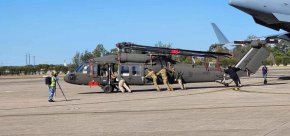No idea what the conops are, if they have even been developed yet. I am looking to what the DSR says is desired, i.e. light forces that can operate effectively from small amphibs.
I also very much like the idea of a Bv410, BvS10 or Bronco style of amphibious all-terrain vehicle for Australia. Personally I lean towards the Bronco but I suspect both families are suitable with very similar capabilities (much like the Redback vs Lynx were for the IFV).
The Royal Marines currently operate the BAE Systems BvS10 vehicles (named in UK service as "Viking") replacing the earlier Bv206, and have on order the more recent Bv410 as a further expansion. The Royal Armoured Corps also operated over 100 of the very similar ST Kinetics Bronco (named in UK service as "Warthog") to supplement the Vikings in Afghanistan; these were purchased in 2008 as an Urgent Operational Requirements package and retained in service until the withdrawal from Afghanistan in 2015. Thales were responsible for the UK mission systems on the Warthogs and were also the UK point of contact for warranty support matters. The UK have used the same four variants of both families of vehicles, being: Troop Carrier, Ambulance, Command, and Repair & Recovery.
According to the UK ministry of defense, "the primary role of the Viking is in protected mobility for the Royal Marines, it is also often used in battlefield reconnaissance, fire support and as a command platform."
In 2009,
Thales and ST Kinetics also offered the French government Broncos, and while their bid lost to the BvS10, it shows that Thales and ST Kinetics would likely be very open to local assembly or production of the Bronco at the Thales protected vehicles manufacturing plant in Bendigo. Thales and ST Kinetics already have agreements in place for manufacturing and marketing of 40mm ammunition here in Australia.
Given this, I think it is an interesting idea for Australia to order local assembly or production of the Bronco 3 by Thales in partnership with ST Kinetics and field them in the role of
Protected Mobility Vehicle, Amphibious All Terrain (PMV-AAT). This would keep production of all three protected mobility platforms unified under Thales using common fit-out, vehicle electronics, mission systems and weapons stations in order to simplify operator training and maintenance across the three PMV platforms.
As for CONOPS, I don't know how to formally describe this, but I see the Australian Army using them with essentially the same doctrine as the Bushmaster (as a protected mobility vehicle) but in situations where their extra mobility and amphibious capabilities can be used to advantage. This would certainly be the case with amphibious landings (no, I know they are not armored amphibious assault vehicles) and across many littoral, riverine and flooded environments. We would certainly do well to look at the ways the royal marines use their BvS10s.
As to numbers and how they would be fielded in the Australian Army, there are a multitude of approaches.
- Using them to establishing for amphibious operations within the new littoral brigade being formed, perhaps representing IOC for the platform.
- Issued across the armor focused brigade replacing Bushmasters (and M113s in roles where the Redback would be overkill)—this is similar to the way Sweden organises their armored brigades with the Bv410 complementing the CV90 IFVs.
- As a high mobility light cavalry company in selected brigades.
- Fielding one company of vehicles for each Bushmaster equipped infantry battalion to be used in place of Bushmasters when desired and for familiarizing motorized infantry on their use during training.
- As a platform for various specialty weapon systems, e.g. NASAMS (like Sweden with the IRIS-T), mortar carrier, electronic warfare, UAS carrier.
- As a battalion-size reserve stockpile for large scale conflict.
- As a potential Antarctic operations vehicle (should conflict arise over the Antarctic treaty or violations of it)
Here is a BvS10 in an amphibious assault ship well dock demonstrating direct landing and return between the ship's well dock to shore. No landing craft required.

UK Viking and HMS Bulwark
UK MoD, OGL v1.0OGL v1.0, via Wikimedia Commons
Here Royal Marines are swimming to shore from a landing craft in BvS10 Vikings during an amphibious landing.

Vikings Float Ashore During Amphibious Assault Phase of Exercise Auriga MOD 45154387
Photo: Petty Officer Husbands/MOD, OGL v1.0OGL v1.0, via Wikimedia Commons
Here is a Royal Thai Army Bronco during the 2010 Thai floods. Looks kinda useful.

Armoured vehicle in Thailand
Government of Thailand, CC BY 2.0 <
Creative Commons — Attribution 2.0 Generic — CC BY 2.0>, via Wikimedia Commons





